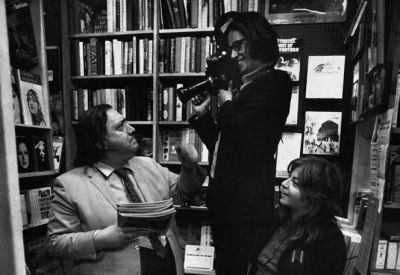
LANGLOIS
(USA/1970) R.: Elia Hershon e Roberto Guerra. D.: 52'. V. inglese
F., M.: Eila Hershon, Roberto Guerra. Int.: Henri Langlois, Jeanne Moreau, Ingrid Bergman, Simone Signoret, Lillian Gish, Catherine Deneuve, Francois Truffaut, Jean Renoir, Viva, Kenneth Anger. Prod.: Eila Hershon, Roberto Guerra . DCP. D.: 52'. Bn e Col. Versione inglese / English version. Da: Cinémathèque Française per concessione di East Village Entertainment, LLC.
Restaurato nel 2014 da / Restored in 2014 by Cinémathèque française e Kathy Brew
Introduce Costantin Costa-Gavras
Vivace omaggio al grande cinefilo e fondatore della Cinémathèque Française, questo documentario offre un ritratto stravagante e aneddotico che alterna interviste ad amici e colleghi di Langlois e filmati di lui che cammina per Parigi parlando a ruota libera un po' di tutto, dalla casa in cui visse Jean Renoir ai cigni bianchi e neri che si sofferma a osservare in un parco.
"Questo nero bellissimo è il nero del cinema" dice indicando un cigno. "Questo" aggiunge indicandone un gruppo "è il bianco e nero del cinema. E il rosso" conclude riferendosi al becco del cigno nero, "è il cuore del cinema". Questo ritratto realizzato da Eila Hershon e Roberto Guerra dimostra che Langlois riusciva a vedere risvolti cinematografici praticamente ovunque, e con appassionata intensità. Simone Signoret racconta come egli fosse capace di interrompere la proiezione di un film se pensava che il pubblico non fosse all'altezza di ciò che stava vedendo: "'No, siete troppo stupidi' diceva, e poi proiettava La corazzata Potëmkin nel soggiorno del piccolo appartamento di sua madre, durante l'occupazione tedesca, quando la proiezione di un film sovietico avrebbe potuto metterlo nei guai". Langlois stesso ricorda che da bambino trovava "quasi insopportabile" guardare film d'ambientazione moderna, perché non riusciva a credere che fossero opere di finzione. Per questo guardava i film storici. Era "un uomo dal destino segnato, nato per fare una sola cosa", racconta Lillian Gish, intervistata nel documentario insieme a Ingrid Bergman, Catherine Deneuve, Jean Renoir, Jeanne Moreau e François Truffaut. Langlois passa in rassegna le case in cui ha vissuto e gli edifici che hanno ospitato la Cinémathèque, della quale si intravede la sede attuale. C'è anche un breve spezzone di cinegiornale che ritrae le animate proteste scoppiate in seguito alla breve destituzione di Langlois dall'incarico di direttore della Cinémathèque all'inizio del 1968, proteste che sono state considerate un antecedente del maggio francese.
Quel che emerge, con forza ancor maggiore dell'amore di Langlois per il cinema, è l'immenso senso di gratitudine espresso nei suoi confronti da tutti coloro che partecipano a questo affettuoso tributo.
Janet Maslin, Langlois' at public, "The New York Times", 5 agosto 1983
This 52-minute documentary, made in 1970, offers a whimsical, anecdotal portrait, interspersing interviews with Mr. Langlois's admiring associates with footage of him as he walks around Paris, holding forth on anything from a house in which Jean Renoir once lived to the black and white swans he spies in a park. "This beautiful black is the black of the cinema", he says, pointing to one swan. "This" - pointing to several - "is the black and white of the cinema. And the red" - indicating the black swan's bill - "is the heart of the cinema". This portrait, by Eila Hershon and Roberto Guerra, makes it clear that Mr. Langlois could find cinematic overtones in virtually anything, and that he did so with passionate intensity. Simone Signoret tells of how Mr. Langlois might halt the showing of a film if he felt the audience to be unworthy of what it was seeing: " 'No, you're too stupid', he would say, and then he'd show them Potemkin in the dining room of Mr. Langlois's mother's tiny apartment, during the German occupation, at a time when the screening of a Soviet film would have been forbidden". Mr. Langlois himself recollects that as a child, he found it "too strong" to watch films whose characters wore modern dress, since it was impossible for him to believe these were works of fiction. So he watched historical films instead.
He was "a man of destiny, born to do one thing", according to Lillian Gish, who, along with Ingrid Bergman, Catherine Deneuve, Jean Renoir, Jeanne Moreau and François Truffaut is interviewed here.
Mr. Langlois points out former homes of his own and of the Cinémathèque, the present-day facilities of which are briefly seen. There is also a bit of newsreel footage of the heated protests against Mr. Langlois's brief dismissal early in 1968, demonstrations that prefigured those that would erupt that May.
What emerges, even more distinctly than the intensity of Mr. Langlois's love of film, is the tremendous debt of gratitude owed him by all those who play a part in this affectionate tribute.
Janet Maslin, 'Langlois' at public, "The New York Times", August 5, 1983

Tariffe:

Numero posti: 144
Aria condizionata
Accesso e servizi per disabili
Il nostro cinema aderisce al circuito CinemAmico: è possibile utilizzare l’applicazione MovieReading® per i film di cui è prevista audiodescrizione e/o sottotitolazione sull'applicazione.
Tel. 0512195311











